MENU
- Home
- Overview
- Attorneys
- Practice Areas
- Firm News
- Blog
- Contact

Silicosis is a lung disease characterized by inflammation and scarring of the lung tissues that reduces the amount of oxygen the lungs can take in and process. Silicosis causes permanent damage to the lungs, and it gets progressively worse and can be fatal. The main cause of silicosis is breathing in crystalline silica, also known as silica dust. The dust contains particles small enough to be respirated or inhaled into the body. The tiny particles become trapped in the lung tissue, where they buildup and cause scarring, which makes the lung tissue stiff.
There are three types of silicosis:
Silica is a crystal that is commonly found everywhere in nature, such as in most rock beds, mineral ores, as well as being a major component of sand. Silica dust is created when rock is being cut or polished, or sand is being used for blasting or glass blowing.
Workers who are at risk of exposure to silica dust include those in the following industries:
Every year, an estimated 2.3 million workers in the United States are exposed to silica dust, according to the Occupational Safety and Health Administration (OSHA). Inhaling the dust formed from processes like cutting, sawing, drilling, crushing, and grinding rock, stone, bricks, mortar, concrete, and blocks puts workers at risk of developing silicosis.
Other operations that present a safety hazard include abrasive blasting with sand, sanding concrete walls, cutting stone countertops, and hydraulic fracturing (fracking). Even if the materials being used contain only a small amount of crystalline silica, if the production method results in a high dust concentration, the outcome is a hazardous level of exposure for the employees.
The OSHA has strict standards for workplaces where silica dust is present. There is a standard for the construction industry, and a standard that applies to general industry and maritime. Both detail the permissible exposure limit averaged over an eight-hour work shift and require employers to use practices that minimize exposure to silica dust.
Some types of silicosis take years and even decades to appear, so a worker may not realize they are suffering from the illness. Early symptoms such as phlegm or a cough that does not go away may not be immediately recognized as silicosis. However, trouble breathing is a tell-tale sign that a worker needs to see a medical professional. Later symptoms of silicosis include fatigue, weight loss, chest pain, shortness of breath, blue lips, and sudden fevers.
Silicosis can be diagnosed with a chest X-ray or CT scan to check for scar tissue in the lungs. A bronchoscopy is a way for the doctor to look inside the lungs for damage via a thin tube with a tiny camera on the end. If a lung tissue biopsy is needed, the doctor will use a needle to take a sample of tissue from a nodule that can be checked under a microscope.
There is no treatment specifically for silicosis. Symptoms may be treated with cough medicine, bronchodilators, and supplemental oxygen. For patients experiencing respiratory infections, antibiotics can be prescribed. To prevent the progression of the disease, it is crucial that the source of silica dust exposure be removed. In severe cases of silicosis, a lung transplant may be necessary.
Workers with chronic silicosis are at higher risk for complications from other illnesses, like tuberculosis, pneumonia, and flu. They also commonly develop other lung diseases, such as lung cancer, chronic bronchitis, and chronic obstructive pulmonary disease (COPD).
An ideal workplace has no materials containing crystalline silica, but this is not always possible. By using good engineering practices and controls, employers can significantly reduce the amount of silica dust produced in the workplace. There should be a written exposure control plan. The following are some of the ways to control silica exposure:
There should also be regular air quality testing to ensure it is within OSHA standards. Workers that work in areas of high exposure should be offered medical exams to monitor their health. Those negligently exposed to silica dust may be able to file a toxic tort claim.
If you have developed an illness as a result of silica dust exposure, contact our experienced Wilmington toxic tort lawyers at Jacobs & Crumplar, P.A. today. Call us at 302-656-5445 or contact us online to schedule a free consultation. Located in Wilmington and Millsboro, Delaware, we represent clients throughout Dover, New Castle County, and Sussex County.